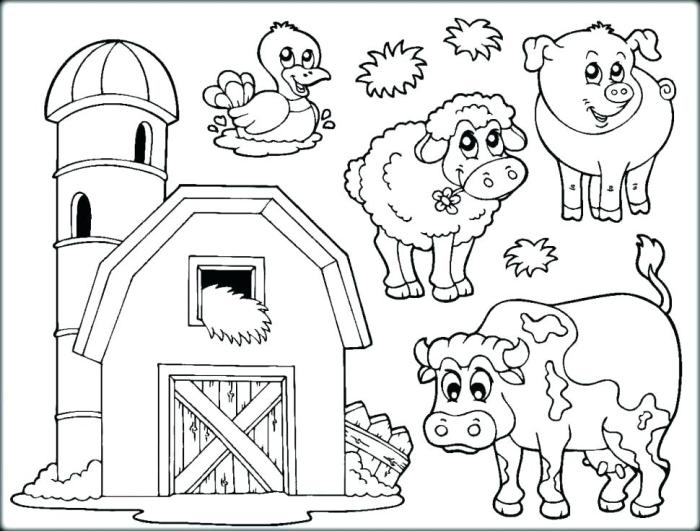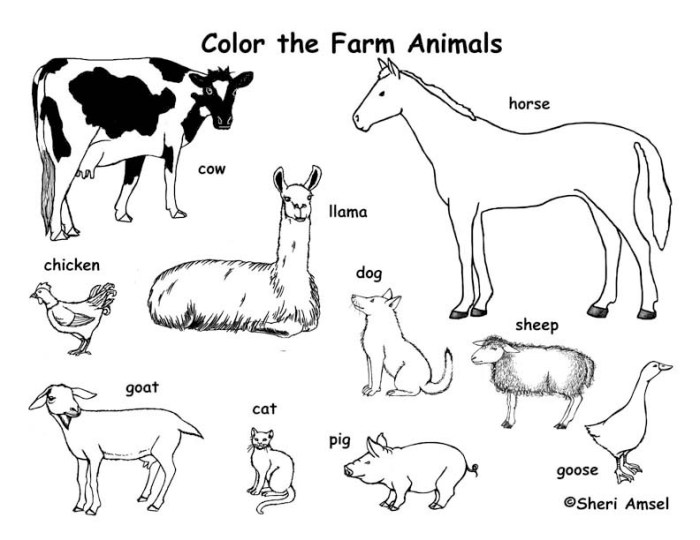Animal Selection and Representation

Realistic farm animal coloring pages – The careful selection of farm animals for realistic coloring pages is paramount. The chosen creatures must offer a compelling range of textures, colors, and forms to challenge and inspire the budding artist. The complexity of their features should cater to various skill levels, ensuring both beginners and experienced colorists find satisfaction in the process. The following selection prioritizes both commonality and visual interest.
The detailed representation of these animals, encompassing their unique physical attributes, is crucial for creating truly engaging coloring pages. Accurate depictions of fur, feathers, skin, and other textural elements will not only enhance the visual appeal but also provide a valuable learning experience for children, fostering a deeper appreciation for the natural world.
Common Farm Animals for Realistic Coloring Pages
Five common farm animals, selected for their diverse visual characteristics and suitability for realistic coloring, are presented below. Each animal offers a unique spectrum of colors, textures, and details, providing a stimulating artistic challenge.
- Cow: The cow’s coat can range from a deep, rich brown to a creamy white, sometimes featuring patches of both. The coloring page should capture the smooth texture of the cow’s hide, contrasted by the coarser texture of its hair around the ears, tail, and muzzle. The intricate detail of its eyes and the subtle shading around its nose and mouth are essential for realism.
- Horse: Horses exhibit a vast array of coat colors, from jet black to snowy white, including chestnuts, bays, and grays. The artist must depict the sheen of the coat, particularly in areas like the neck and flanks, and the differences in texture between the mane and tail, which are typically long and flowing. Musculature should be subtly suggested, highlighting the powerful build of the animal.
- Pig: Pigs possess a distinctive, wrinkled skin, often exhibiting a pinkish hue, which can darken to a reddish-brown in some breeds. The coloring page should effectively capture this textural complexity, showing the folds and creases in the skin. The short, bristly hair should be represented, and the snout and ears should be rendered with particular attention to detail.
- Sheep: Sheep offer a unique textural challenge, with their thick, woolly coats. The coloring page should depict the density and variations in the wool, which can range in color from pure white to various shades of brown and black. The delicate features of the sheep’s face, including its eyes and muzzle, should be carefully rendered.
- Chicken: Chickens present a fascinating array of colors and textures in their feathers. The page should capture the smooth, glossy texture of the feathers, their varying colors (from bright reds and yellows to browns and blacks), and the different feather patterns. The comb and wattles should be depicted with their characteristic vibrant redness and slightly bumpy texture.
Sample Page Layout
A suggested layout for a single page would feature the five animals arranged in a visually appealing manner. The cow, as the largest animal, could occupy the lower left quadrant, approximately one-third of the page. The horse would be positioned diagonally opposite, in the upper right quadrant, roughly the same size as the cow. The pig, sheep, and chicken would be smaller, arranged in a triangular formation in the remaining space, with the pig positioned centrally below the horse and the sheep and chicken flanking it.
The comforting familiarity of realistic farm animal coloring pages, with their gentle cows and playful piglets, always soothes my soul. Sometimes, though, I crave a splash of vibrant fantasy, and that’s when I turn to the enchanting world of anime mermaid coloring pages , their shimmering scales and flowing hair a delightful contrast. Then, I return to the earthy hues of the farm animals, appreciating their quiet beauty all the more.
This layout balances the size and visual weight of the animals, creating a dynamic and engaging composition.
Educational Aspects

Realistic farm animal coloring pages transcend mere entertainment; they serve as potent tools for enriching a child’s understanding of the agricultural world and fostering essential developmental skills. These vibrant depictions offer a unique gateway to learning, transforming a simple activity into a multifaceted educational experience. The detailed illustrations spark curiosity and ignite a child’s imagination, paving the way for deeper knowledge acquisition.These coloring pages contribute significantly to a child’s burgeoning knowledge of farm animals.
Children learn to identify various breeds of animals, recognize their distinctive features, and grasp their roles within the farming ecosystem. The visual engagement fosters memorization and strengthens cognitive connections between the animal’s image and its name, characteristics, and habitat. The act of coloring itself deepens this learning, reinforcing the visual information through active participation.
Fine Motor Skill Development
The meticulous process of coloring within the lines, shading different areas, and controlling the pressure applied to the crayon or colored pencil significantly enhances a child’s fine motor skills. This controlled hand-eye coordination is crucial for future writing, drawing, and other intricate manual tasks. The repetitive movements strengthen the muscles in the hands and fingers, improving dexterity and precision.
This improvement translates to better handwriting, improved drawing abilities, and enhanced overall manual dexterity, laying a solid foundation for future academic and practical skills.
Educational Elements Integration, Realistic farm animal coloring pages
Incorporating educational elements directly into the coloring pages elevates their pedagogical value. Simple additions such as labeling key body parts (e.g., “tail,” “hoof,” “horn”) introduce basic anatomy and vocabulary. Including short, age-appropriate facts about the animal’s diet, habitat, or behavior adds another layer of learning. For example, a coloring page featuring a cow could include a fact box stating: “Cows are herbivores and eat grass!” This multi-sensory approach, combining visual learning with textual information, creates a holistic and engaging learning experience.
Example Coloring Page Design
Consider a coloring page depicting a hen and her chicks. The hen would be realistically rendered, showing her plumage details and characteristic posture. Her body parts (beak, comb, wing, tail, legs, claws) would be clearly labeled with simple, easy-to-read text. Surrounding the hen and chicks would be a small field of grass, perhaps with a few insects or worms subtly depicted, hinting at their diet.
A small text box could provide a fact: “Hens lay eggs that hatch into chicks!” This design seamlessly integrates educational elements with an engaging visual representation, transforming a coloring activity into a mini-lesson about poultry. The realistic rendering ensures accuracy and fosters a deeper understanding of the animal’s appearance, enhancing the learning experience. The use of bold, clear fonts and bright colors makes the information easily accessible and engaging for young learners.
Questions and Answers: Realistic Farm Animal Coloring Pages
Where can I find these coloring pages?
Dude, tons of places! Check Etsy, online art stores, or even make your own!
Are these coloring pages only for young kids?
Nah, they’re for everyone! Even adults find them relaxing and fun.
What kind of supplies do I need?
Crayons, colored pencils, markers – whatever you vibe with!
Can I print these at home?
Totally! Just make sure you have a decent printer and some good paper.
